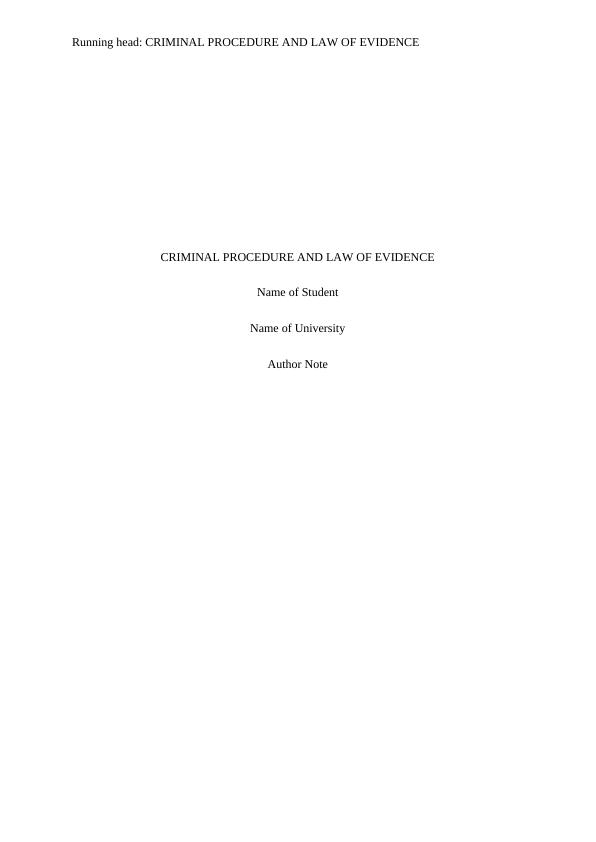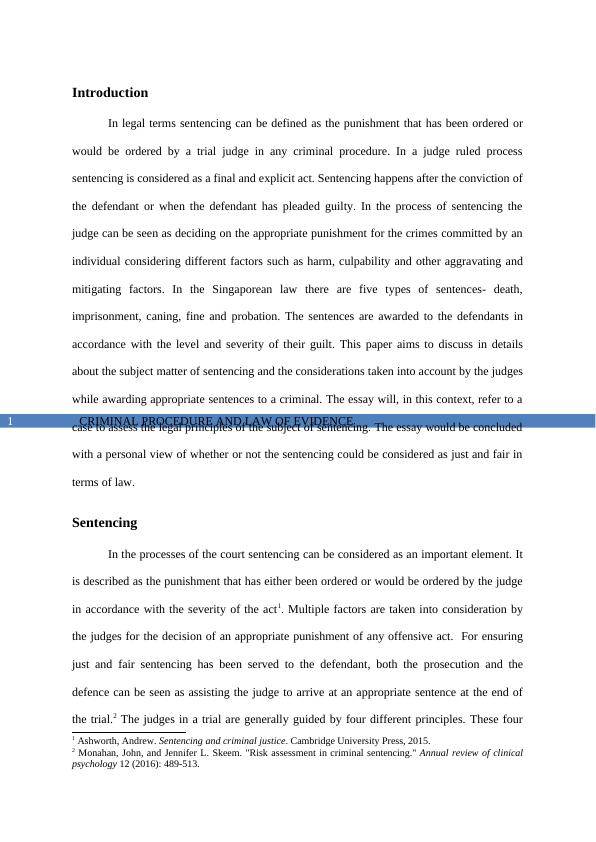Sentencing Considerations by Judges in Singapore: A Case Study
Added on 2022-11-14
11 Pages3030 Words415 Views
Running head: CRIMINAL PROCEDURE AND LAW OF EVIDENCE
CRIMINAL PROCEDURE AND LAW OF EVIDENCE
Name of Student
Name of University
Author Note
CRIMINAL PROCEDURE AND LAW OF EVIDENCE
Name of Student
Name of University
Author Note

CRIMINAL PROCEDURE AND LAW OF EVIDENCE1
Introduction
In legal terms sentencing can be defined as the punishment that has been ordered or
would be ordered by a trial judge in any criminal procedure. In a judge ruled process
sentencing is considered as a final and explicit act. Sentencing happens after the conviction of
the defendant or when the defendant has pleaded guilty. In the process of sentencing the
judge can be seen as deciding on the appropriate punishment for the crimes committed by an
individual considering different factors such as harm, culpability and other aggravating and
mitigating factors. In the Singaporean law there are five types of sentences- death,
imprisonment, caning, fine and probation. The sentences are awarded to the defendants in
accordance with the level and severity of their guilt. This paper aims to discuss in details
about the subject matter of sentencing and the considerations taken into account by the judges
while awarding appropriate sentences to a criminal. The essay will, in this context, refer to a
case to assess the legal principles of the subject of sentencing. The essay would be concluded
with a personal view of whether or not the sentencing could be considered as just and fair in
terms of law.
Sentencing
In the processes of the court sentencing can be considered as an important element. It
is described as the punishment that has either been ordered or would be ordered by the judge
in accordance with the severity of the act1. Multiple factors are taken into consideration by
the judges for the decision of an appropriate punishment of any offensive act. For ensuring
just and fair sentencing has been served to the defendant, both the prosecution and the
defence can be seen as assisting the judge to arrive at an appropriate sentence at the end of
the trial.2 The judges in a trial are generally guided by four different principles. These four
1 Ashworth, Andrew. Sentencing and criminal justice. Cambridge University Press, 2015.
2 Monahan, John, and Jennifer L. Skeem. "Risk assessment in criminal sentencing." Annual review of clinical
psychology 12 (2016): 489-513.
Introduction
In legal terms sentencing can be defined as the punishment that has been ordered or
would be ordered by a trial judge in any criminal procedure. In a judge ruled process
sentencing is considered as a final and explicit act. Sentencing happens after the conviction of
the defendant or when the defendant has pleaded guilty. In the process of sentencing the
judge can be seen as deciding on the appropriate punishment for the crimes committed by an
individual considering different factors such as harm, culpability and other aggravating and
mitigating factors. In the Singaporean law there are five types of sentences- death,
imprisonment, caning, fine and probation. The sentences are awarded to the defendants in
accordance with the level and severity of their guilt. This paper aims to discuss in details
about the subject matter of sentencing and the considerations taken into account by the judges
while awarding appropriate sentences to a criminal. The essay will, in this context, refer to a
case to assess the legal principles of the subject of sentencing. The essay would be concluded
with a personal view of whether or not the sentencing could be considered as just and fair in
terms of law.
Sentencing
In the processes of the court sentencing can be considered as an important element. It
is described as the punishment that has either been ordered or would be ordered by the judge
in accordance with the severity of the act1. Multiple factors are taken into consideration by
the judges for the decision of an appropriate punishment of any offensive act. For ensuring
just and fair sentencing has been served to the defendant, both the prosecution and the
defence can be seen as assisting the judge to arrive at an appropriate sentence at the end of
the trial.2 The judges in a trial are generally guided by four different principles. These four
1 Ashworth, Andrew. Sentencing and criminal justice. Cambridge University Press, 2015.
2 Monahan, John, and Jennifer L. Skeem. "Risk assessment in criminal sentencing." Annual review of clinical
psychology 12 (2016): 489-513.

CRIMINAL PROCEDURE AND LAW OF EVIDENCE2
principles are- retribution, deterrence, prevention and rehabilitation. According to the
principle of retribution an offender is required to be punished in accordance with the
culpability and the seriousness of the crime committed by him.3 The deterrence principle is
subdivided into two categories- general deterrence and specific deterrence4. The principle of
general deterrence can be observed as aiming to discourage individuals from engaging in
behaviours of offence for which the sentence has been meted out. By way of the specific
deterrence the offender is targeted for discouraging him from committing offence again5. The
main aim of the principle of the prevention is to physically incapacitate the offenders by way
of locking them away so that they are unable to cause any further damage.6 The final
principle, that is the principle of rehabilitation, mostly focuses on the capability of the
offender to reform and in accordance to such capability meting out the punishment that would
be the most appropriate for helping n the reformation.7
Sentencing in criminal justice system can be seen as serving two specific purposes.
The first purpose is to deter future crimes by the offenders as well as the individuals who
have a probability of commitment of similar crime. The second purpose of sentencing is to
serve as a retributive agent by punishing the offenders for acting in an offensive manner.
The judges can be seen as playing an important role in ensuring a just and fair trial
and sentencing. To ensure fairness the judges are required to be playing an active role at the
time of the trial. In furtherance to this the judges are required to carefully consider all the
circumstances and the evidence that have been submitted.
3 Zaibert, Leo. Punishment and retribution. Routledge, 2016.
4 Chalfin, Aaron, and Justin McCrary. "Criminal deterrence: A review of the literature." Journal of Economic
Literature 55.1 (2017): 5-48.
5 Nagin, Daniel S., Robert M. Solow, and Cynthia Lum. "Deterrence, criminal opportunities, and
police." Criminology 53.1 (2015): 74-100.
6 Crawford, Adam, and Karen Evans. Crime prevention and community safety. Oxford University Press, 2017.
7 Bonta, James, and Donald Arthur Andrews. The psychology of criminal conduct. Routledge, 2016.
principles are- retribution, deterrence, prevention and rehabilitation. According to the
principle of retribution an offender is required to be punished in accordance with the
culpability and the seriousness of the crime committed by him.3 The deterrence principle is
subdivided into two categories- general deterrence and specific deterrence4. The principle of
general deterrence can be observed as aiming to discourage individuals from engaging in
behaviours of offence for which the sentence has been meted out. By way of the specific
deterrence the offender is targeted for discouraging him from committing offence again5. The
main aim of the principle of the prevention is to physically incapacitate the offenders by way
of locking them away so that they are unable to cause any further damage.6 The final
principle, that is the principle of rehabilitation, mostly focuses on the capability of the
offender to reform and in accordance to such capability meting out the punishment that would
be the most appropriate for helping n the reformation.7
Sentencing in criminal justice system can be seen as serving two specific purposes.
The first purpose is to deter future crimes by the offenders as well as the individuals who
have a probability of commitment of similar crime. The second purpose of sentencing is to
serve as a retributive agent by punishing the offenders for acting in an offensive manner.
The judges can be seen as playing an important role in ensuring a just and fair trial
and sentencing. To ensure fairness the judges are required to be playing an active role at the
time of the trial. In furtherance to this the judges are required to carefully consider all the
circumstances and the evidence that have been submitted.
3 Zaibert, Leo. Punishment and retribution. Routledge, 2016.
4 Chalfin, Aaron, and Justin McCrary. "Criminal deterrence: A review of the literature." Journal of Economic
Literature 55.1 (2017): 5-48.
5 Nagin, Daniel S., Robert M. Solow, and Cynthia Lum. "Deterrence, criminal opportunities, and
police." Criminology 53.1 (2015): 74-100.
6 Crawford, Adam, and Karen Evans. Crime prevention and community safety. Oxford University Press, 2017.
7 Bonta, James, and Donald Arthur Andrews. The psychology of criminal conduct. Routledge, 2016.

End of preview
Want to access all the pages? Upload your documents or become a member.
Related Documents
Sentencing Law: Understanding the Significance of Denunciation in Criminal Justice Systemlg...
|10
|2685
|153
Purpose of Criminal Law and Conviction of Fraud under Fraud Act 2006lg...
|7
|1395
|91
Criminal Law and Sentencing in Canadian Judicial Systemlg...
|8
|2293
|74
Solved: Criminal Law Assignmentlg...
|13
|4717
|18
Types of Sentences in Criminal Courtslg...
|6
|1538
|32
Criminal Justice Assignment 2022lg...
|6
|1425
|18
